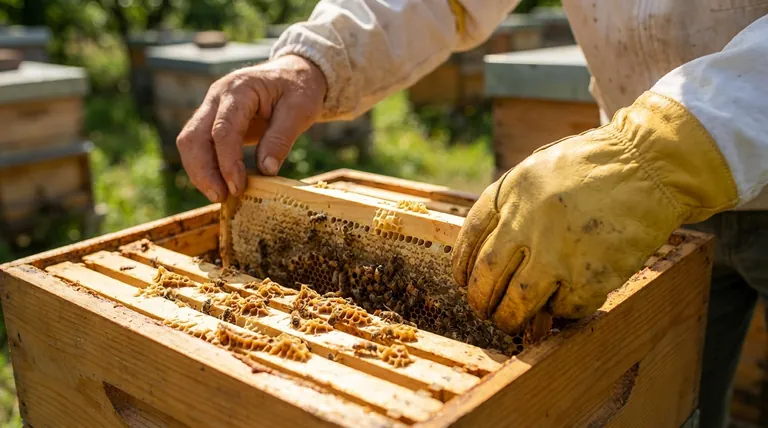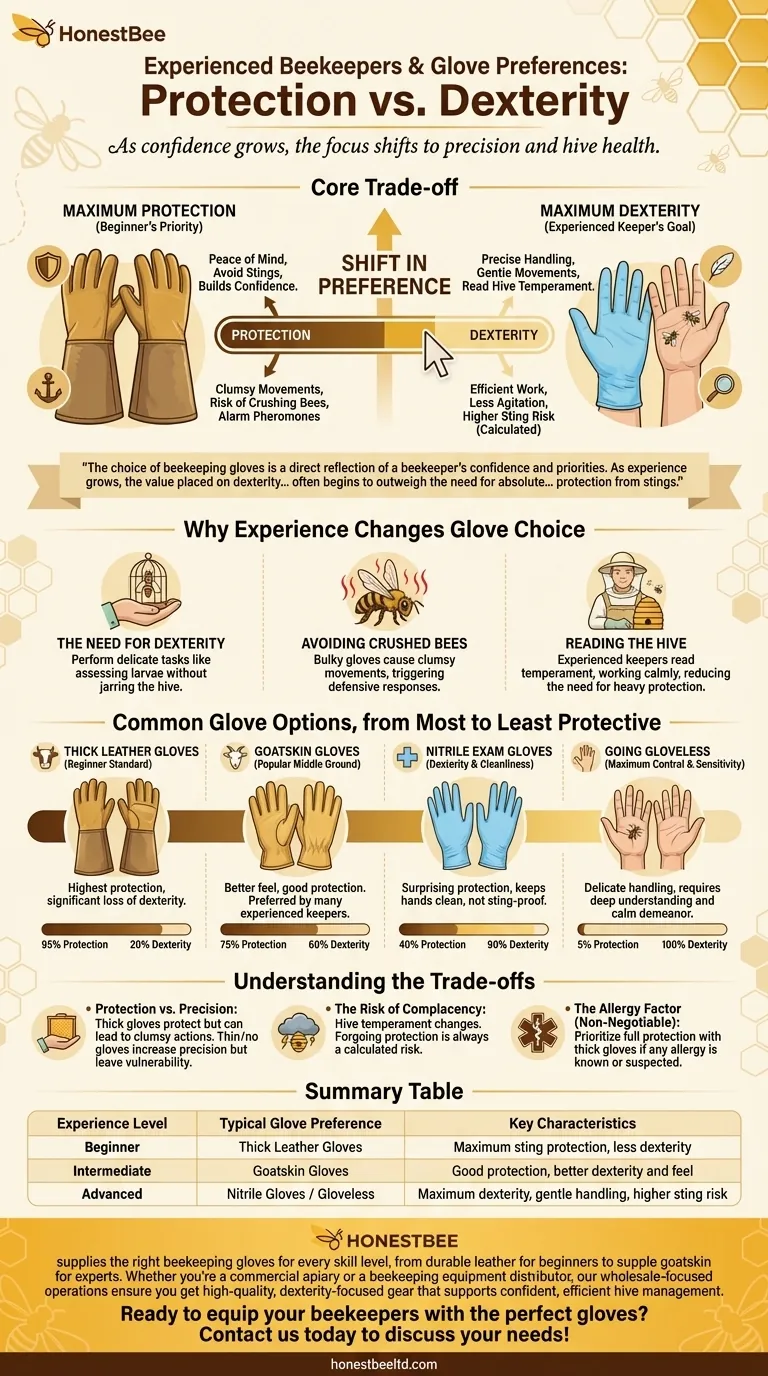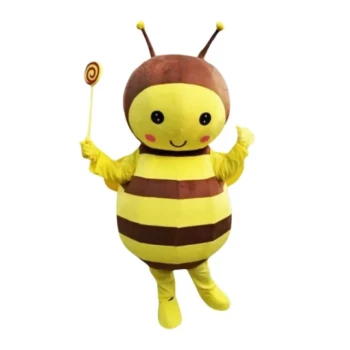For experienced beekeepers, the preference often shifts from maximum protection towards maximum dexterity and a better "feel" for the hive. This means many will opt for thinner gloves made of goatskin or nitrile, while some of the most confident beekeepers choose to wear no gloves at all, accepting the risk of stings for more precise and gentle handling of their bees.
The choice of beekeeping gloves is a direct reflection of a beekeeper's confidence and priorities. As experience grows, the value placed on dexterity and the ability to handle bees gently often begins to outweigh the need for absolute, guaranteed protection from stings.

Why Experience Changes Glove Choice
For a beginner, the primary goal is to avoid stings and build confidence. Thick gloves provide peace of mind. However, an experienced keeper's goals evolve, focusing more on the health of the colony and the efficiency of their work.
The Need for Dexterity
Thick leather gloves, while highly protective, are cumbersome. They make it difficult to perform delicate tasks like picking up a queen bee, assessing larvae, or manipulating frames without jarring the hive.
Avoiding Crushed Bees
Clumsy movements caused by bulky gloves can easily crush bees. A crushed bee releases an alarm pheromone, which signals a threat to the rest of the colony and can trigger a defensive response, leading to more stings.
Reading the Hive
Experienced beekeepers become adept at reading the temperament of a hive. They gain confidence in their movements and learn to work calmly and deliberately, reducing the bees' agitation and, consequently, the perceived need for heavy protection.
Common Glove Options, from Most to Least Protective
The journey from beginner to expert can often be tracked by the type of glove a beekeeper chooses. Each type represents a different point on the spectrum between protection and control.
Thick Leather Gloves
These are the standard for beginners. Often made of cowhide and extending up the arm, they offer the highest level of protection from stings. Their main drawback is a significant loss of dexterity.
Goatskin Gloves
This is a popular middle ground. Goatskin is more supple and thinner than cow leather, providing a much better feel for the equipment while still offering good sting protection. Many experienced keepers who still prefer a glove settle here.
Nitrile Exam Gloves
For those prioritizing dexterity and cleanliness, nitrile gloves are a common choice. They keep hands free of sticky honey and propolis and offer surprising protection against stings, though they are not completely sting-proof.
Going Gloveless
This is the choice for beekeepers who value maximum control and sensitivity. Working without gloves allows for the most delicate handling of bees and frames, but it requires a deep understanding of bee behavior and a calm demeanor.
Understanding the Trade-offs
Choosing a glove is not just about preference; it's about making a calculated decision based on a core conflict.
Protection vs. Precision
This is the central trade-off. Thick gloves protect your hands but can lead to clumsy actions that provoke the bees. Thinner gloves or no gloves increase precision and gentleness but leave you more vulnerable to stings.
The Risk of Complacency
Hive temperament can change based on weather, season, or a recent disturbance. Even the most experienced beekeeper working with a gentle colony can face an aggressive hive. Forgoing protection is always a calculated risk.
The Allergy Factor
This is non-negotiable. Any beekeeper with a known or suspected allergy to bee venom should always prioritize full protection with thick, sting-proof gloves, regardless of their experience level.
Making the Right Choice for Your Goal
Your glove choice should align with your experience level and primary objective during a hive inspection.
- If your primary focus is avoiding stings and building confidence: Use thick leather or goatskin gloves for maximum protection.
- If your primary focus is a balance of safety and dexterity: Goatskin gloves are the ideal choice for most experienced beekeepers.
- If your primary focus is maximum control and gentle handling: Consider thin nitrile gloves or, once highly confident, no gloves at all.
Ultimately, the right glove is the one that allows you to work calmly, confidently, and effectively for the well-being of your bees.
Summary Table:
| Experience Level | Typical Glove Preference | Key Characteristics |
|---|---|---|
| Beginner | Thick Leather Gloves | Maximum sting protection, less dexterity |
| Intermediate | Goatskin Gloves | Good protection, better dexterity and feel |
| Advanced | Nitrile Gloves / Gloveless | Maximum dexterity, gentle handling, higher sting risk |
HONESTBEE supplies the right beekeeping gloves for every skill level, from durable leather for beginners to supple goatskin for experts. Whether you're a commercial apiary or a beekeeping equipment distributor, our wholesale-focused operations ensure you get high-quality, dexterity-focused gear that supports confident, efficient hive management. Ready to equip your beekeepers with the perfect gloves? Contact us today to discuss your needs!
Visual Guide

Related Products
- Beekeeping Gloves Goatskin Leather with Long Cotton Sleeve for Beekeepers
- Goatskin Leather Beekeeper Gloves with Vent Long Sleeve for Beekeeping Honey Bee Sting Proof Protection
- Goat Skin Leather Bee Sting Proof Beekeeping Gloves with Canvas Sleeve
- Mesh Ventilated 3 Layer Goatskin Beekeepers Gloves for Beekeeping
- Professional Galvanized Hive Strap with Secure Locking Buckle for Beekeeping
People Also Ask
- Why do some experienced beekeepers choose not to wear gloves? For Superior Dexterity & Hive Welfare
- Why are protective gloves important in beekeeping? Boost Confidence & Safety in Your Apiary
- What should beekeepers consider regarding the fit of beekeeping gloves? Achieve Safety and Dexterity
- What are the advantages of goatskin leather gloves for beekeeping? Superior Sting Protection for Your Apiary
- Why is dexterity and flexibility important in beekeeping gloves? Boost Your Hive Management Efficiency



















